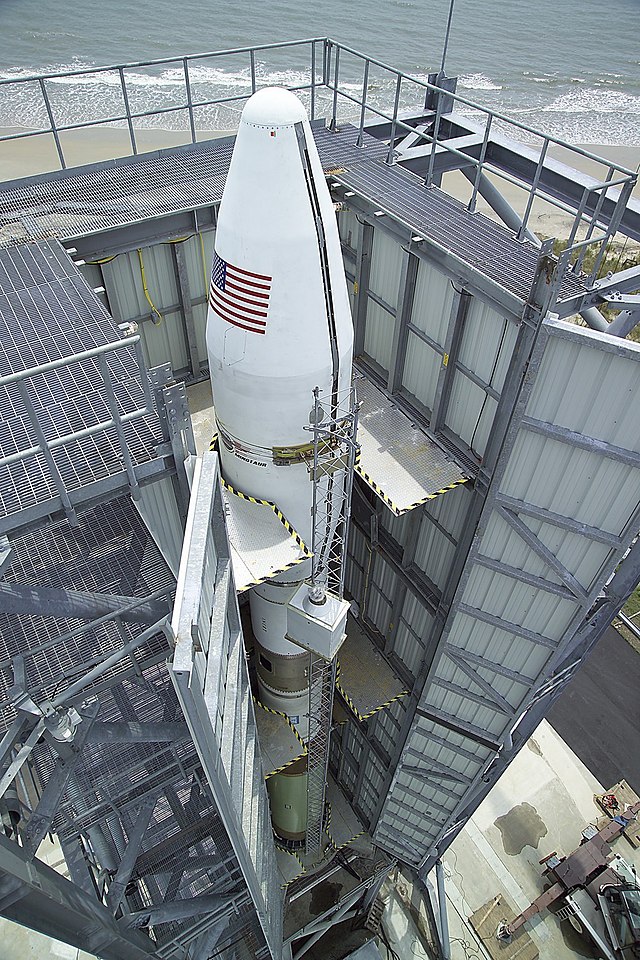Top Qs
Timeline
Chat
Perspective
Minotaur (rocket family)
Family of American rockets From Wikipedia, the free encyclopedia
Remove ads
The Minotaur is a family of United States solid-fuel launch vehicles repurposed from retired Minuteman and Peacekeeper model intercontinental ballistic missiles. Built by Northrop Grumman under the Space Force's Rocket Systems Launch Program, these vehicles are used for various space and test launch missions.


The Minotaur family consists of four main variants: the Minotaur I, primarily used for launching small satellites into low Earth orbit; the Minotaur II, primarily used as a suborbital target vehicle; the Minotaur IV, a small-lift launch vehicle; and the Minotaur V, capable of reaching higher orbits, including geostationary transfer orbit and trans-lunar trajectories. Minotaur I and II are derived from the Minuteman missile, while Minotaur IV, V, and the cancelled Minotaur III are based on the Peacekeeper ICBM.
Remove ads
Vehicles
Summarize
Perspective
Minotaur-C (Taurus)
The Taurus launch vehicle, later renamed[1] Minotaur-C (for "Minotaur-Commercial"), was the first of the Minotaur vehicle family, and the first ground-launched orbital booster developed by Orbital Sciences Corporation (OSC), derived by adding a solid booster stage to the air-launched Pegasus rocket.
The first flight, sponsored by DARPA, was in 1994. After a series of failures between 2001 and 2011, the launch vehicle was rebranded as Minotaur-C in 2014. Due to laws against selling government equipment, the Minotaur-C is the only available Minotaur launch vehicle for commercial launches.[citation needed]
Minotaur I

The original Minotaur launch vehicle, consisting of an M55A1 first stage, SR19 second stage, Orion 50XL third stage, Orion 38 fourth stage, and optional HAPS fifth stage for velocity trim and multiple payload deployment. Payload 580 kg to a 185 km, 28.5° orbit from Cape Canaveral; or 310 kg to a 740 km Sun-synchronous orbit (SSO) from Vandenberg.[2]
Minotaur II
A suborbital target vehicle, essentially consisting of a Minuteman II with Orbital guidance and control systems. Consists of M55A1 first stage, SR19 second stage, and M57 third stage. Payload 460 kg on 6700 km suborbital trajectory.[2]
Minotaur III

A suborbital target vehicle, consisting of an SR118 first stage, SR119 second stage, SR120 third stage, and Super HAPS fourth stage. Payload 3060 kg on a 6700 km suborbital trajectory.[2] The vehicle's development was cancelled and the Minotaur III was never flown.[citation needed]
Minotaur IV

The Minotaur IV combines U.S. government-furnished solid rocket motors from decommissioned Peacekeeper ICBMs with technologies from other Orbital-built launch vehicles, including the Minotaur I, Pegasus, and Taurus. The Minotaur IV launch vehicle consists of an SR118 first stage, SR119 second stage, SR120 third stage, and Orion 38 fourth stage. Payload 1735 kg to a 185 km, 28.5° orbit from Cape Canaveral.
The first Minotaur IV was launched 22 April 2010 from Vandenberg Air Force Base in California.[3] This vehicle is also being developed to accommodate the Conventional Prompt Global Strike (CPGS) mission for the Air Force.
Minotaur V

The Minotaur V is a five-stage version based on the Minotaur IV+. It has an additional upper stage for small geostationary transfer orbit (GTO), lunar, and interplanetary missions.
NASA's Lunar Atmosphere and Dust Environment Explorer (LADEE) mission was launched on the first Minotaur V, from the Wallops Island, Virginia launch site at 03:27 UTC on 7 September 2013. The Minotaur launched the LADEE spacecraft into a highly elliptic orbit where it can phase and time its trajectory burn to the moon.[4]
Minotaur VI
The Minotaur VI is a five-stage launch vehicle proposed by Northrop Grumman that, as of 2025, has not flown. Minotaur VI is based on the Minotaur IV+, adding a second SR-118 first stage to increase performance.[5] A further enhanced variant, Minotaur VI+, is also proposed for beyond low Earth orbit missions using an added Star 37FM sixth stage motor. For example, Minotaur VI+ can send up to 300 kilograms (660 lb) of payload to Mars.
Remove ads
Launch statistics
Rocket configurations
1
2
3
4
5
'94
'95
'96
'97
'98
'99
'00
'01
'02
'03
'04
'05
'06
'07
'08
'09
'10
'11
'12
'13
'14
'15
'16
'17
'18
'19
'20
'21
'22
'23
'24
- Minotaur-C
- Minotaur I
- Minotaur II
- Minotaur II+
- Minotaur IV
- Minotaur IV Lite
- Minotaur IV HAPS
- Minotaur IV+
- Minotaur V
Launch sites
1
2
3
4
5
'94
'95
'96
'97
'98
'99
'00
'01
'02
'03
'04
'05
'06
'07
'08
'09
'10
'11
'12
'13
'14
'15
'16
'17
'18
'19
'20
'21
'22
'23
'24
- Vandenberg, LF-06
- Vandenberg, SLC-8
- Vandenberg, SLC-576E
- Vandenberg, TP-01
- Kodiak Island, LP-1
- Cape Canaveral, SLC-46
- MARS, LP-0B
Launch outcomes
1
2
3
4
5
'94
'95
'96
'97
'98
'99
'00
'01
'02
'03
'04
'05
'06
'07
'08
'09
'10
'11
'12
'13
'14
'15
'16
'17
'18
'19
'20
'21
'22
'23
'24
'25
- Success
- Failure
- Planned
Remove ads
Launch history
Remove ads
Planned launches
See also
- Dnepr, a converted Soviet ICBM often used for commercial satellite launches
- Modified Minotaur IV (Ascent Abort-2), Ascent Abort-2 (AA-2), was a suborbital flight to test the Launch Abort System (LAS) of NASA's Orion spacecraft. The suborbital flight used a modified Minotaur IV, launched 2 July 2019, at 11:00 UTC from CCAFS SLC-46. The suborbital flight was a success.
References
External links
Wikiwand - on
Seamless Wikipedia browsing. On steroids.
Remove ads
